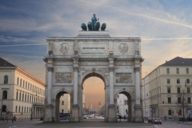
The triumphal arch situated at the beginning of the city’s picturesque Leopoldstrasse boulevard is a larger-than-life testament to Munich's love for Italy, while also acting as an important memorial to peace.
The Siegestor – atop which sits the statue of Bavaria with a lion-quadriga – marks the end of Ludwigstrasse and the beginning of Munich's Schwabing district.
When construction work began on the new boulevard – named after its patron and King, Ludwig I – in the mid-19th century, Schwabing was still a village. Fields and meadows lay strewn beyond the fortified gate. The Triumphal Arch is the equivalent of the Feldherrnhalle monument located on Odeonsplatz, both of which were commissioned by the King and brought to life by the architect Friedrich von Gärtner.
Inspiration for the gate was drawn from the Arch of Constantine in Rome. Just as with the Feldherrnhalle, Ludwig I also commissioned the Siegestor to be built in honour of the Bavarian army.
The inscription on the side facing towards Schwabing is an enduring witness to this dedication, as well as the motifs depicting the battle scenes.
On the other hand, the inscription on the south-facing side, which was added after 1945, speaks a very different language. "Dedicated to victory - Destroyed by war - An admonishment for peace," it says. During the Second World War, the gate was badly damaged. In view of the severe destruction caused by the War and the associated guilt, reconstruction efforts deliberately avoided any kind of fuss and transformed the gate into a memorial for peace.
At the 1972 Summer Olympics in Munich, the lovingly-restored lion-quadriga was returned to its place atop the gate. Since the reign of Ludwig I, Munich has grown strongly northwards. Behind the Siegestor itself, Schwabing's Leopoldstrasse boulevard begins with all its cafés and shops. On a visual axis from Odeonsplatz and stretching to the north, modern city buildings such as the 123-metre-high Langenscheidt skyscraper tower above the Siegestor, situated at the end of Ludwigstrasse.